One day before the NFL Draft, the Chicago Bears made another kind of splash as they revealed an inside look for the first time at their proposal to build a new stadium in Chicago.
Details from location to the roof to traffic to financing to what will become of Soldier Field and more were revealed during the team's big press conference.
But for fans trying to grasp what exactly happened, here are some of the biggest takeaways:
1. What it will look like
The team released renderings of the new, covered stadium Wednesday, showing plans for both inside and outside.
(See the full renderings here)
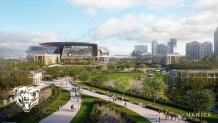
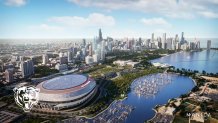

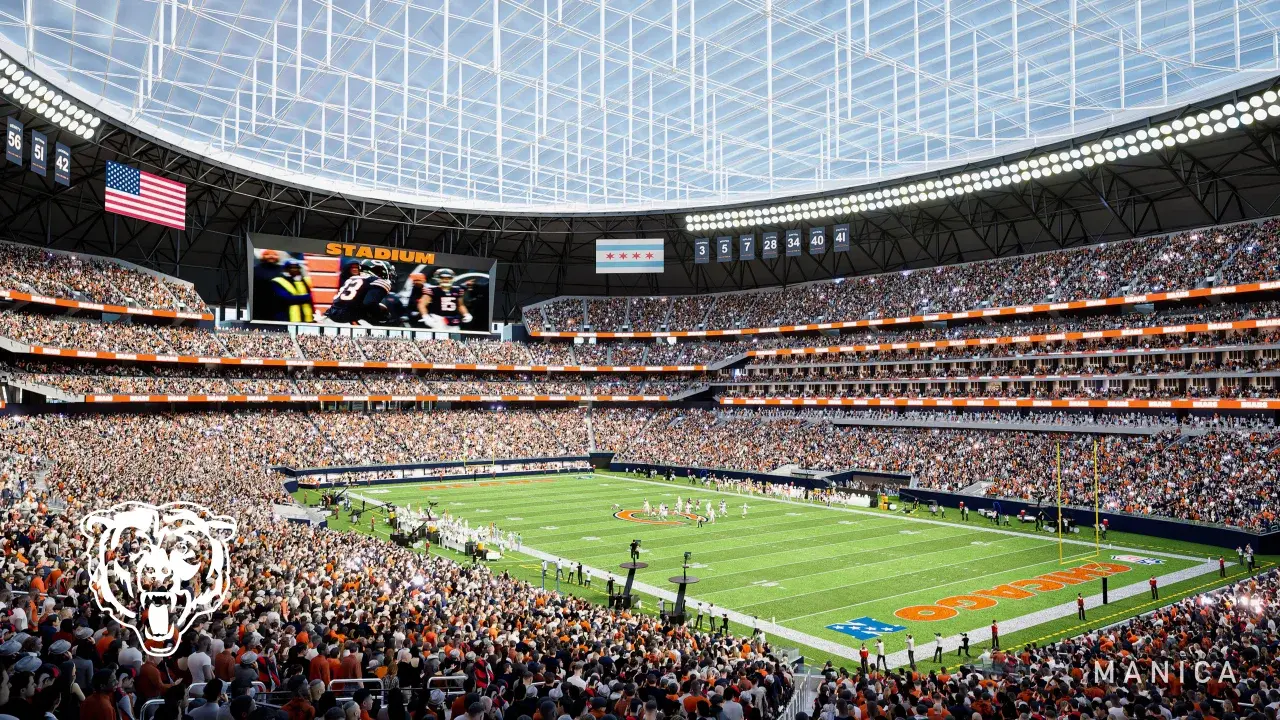
Feeling out of the loop? We'll catch you up on the Chicago news you need to know. Sign up for the weekly Chicago Catch-Up newsletter here.
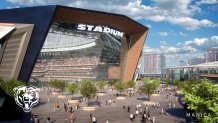
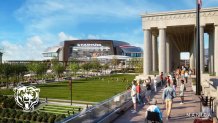
In addition to the renderings, the team also released a "hype video" showcasing the new plans.
Chicago Bears
WATCH: Here's the compelling stadium hype video the Bears played at their press conference
2. What happens to Soldier Field?
Soldier Field, which has been constructed and standing for nearly 100 years, is absent from the renderings. The historic columns, which are part of the architecture that "pays homage to the men and women who valiantly served the country," according to Landmarks Illinois, remain in the renderings.
"Sports fields and gardens will replace the current stadium, with Soldier Field’s historic colonnades preserved as a tribute to Chicago’s military veterans," the team said in a release. "An enclosed stadium is essential for Chicago to attract year-round events like the Super Bowl and major concerts—unlocking billions in tourism revenue."
"As you noticed here, the plan is to keep the historical columns from Soldier Field to make that part of this development to make it one museum campus," Bears CEO/President Kevin Warren said during a visual presentation of the renderings. "What happens here is the additional open and green space. This will have 14 acres of athletic fields, a recreational park to allow, as I mentioned earlier, for youth to be able to come together and do things in a productive manner."
As for the transition to the new stadium, Warren said the Bears will play at Soldier Field until the construction of the new stadium is complete for them to play in.
"One of the things that makes the project unique is that we would be able to continue to play at Soldier Field during the construction and then to be able to move into the new stadium once the construction is finalized," Warren said. "So yes, we would be able to continue to play here and not have to move to a different location."
3. What will the roof be like?
The Bears revealed plans for a "state-of-the-art" fixed, not a retractable roof on the stadium. Warren said while the team considered a retractable roof, it would have added "another couple hundred million dollars."
"When we talked to organizations who had retractable roofs, they said they used it maybe three or four times a year," he said.
Warren said the roof will be similar to ones seen at US Bank Stadium in Minnesota or Allegiant Stadium in Las Vegas or SoFi Stadium in California.
"You'll be indoors, you'll get all the benefits of being indoors, but you'll feel like you're outdoors. You may have to wear sunglasses," he said.
4. What about traffic and parking?
With the increased capacity and usage, as opposed to Soldier Field, the Bears and the city of Chicago will surely run into traffic problems. Already, traffic problems exist with entering and exiting the lakefront campus; whether on foot or behind a wheel.
Bears newly appointed Chief Operating Officer Karen Murphy laid out the plan for traffic to the proposed stadium.
The first phase of the plan includes creating an "improved interchange" at 18th Street, which would become 19th Street on Lakeshore Drive. They're also looking at an entrance to the campus from the South to tie into their South parking lot.
Double-decking the South parking lot is also in the realm of possibilities.
On the North side, the Bears are looking to remove the light on Lakeshore Drive and McFetridge. They also hope to increase the space and accessibility on the lakefront path for pedestrians who are walking to the stadium.
The Bears estimate a 20% increase in campus capacity on the South side, with a 10-minute reduction in campus exit time. On the North side, they estimate a 50% increase in campus access --- likely because of the destruction of Soldier Field.
"If both these phases are done, this would be a 50% increase in lane capacity to the site, as well as a 20-minute reduction in exit times from our parking ramps, and 1,200 less hours daily for commuters on DuSable Lakeshore Drive," Murphy said during the presentation.
5. How will the stadium be financed?
The Bears announced how they plan to fund a potential new stadium project in Chicago, and how much they believe it will cost.
Bears COO and executive vice president of stadium development Karen Murphy said in a presentation on Wednesday that the team expects the entire stadium project to cost $4.7 billion: $3.2 for the stadium itself and just over $300 million for the infrastructure required to open it, then $1.2 billion for two other phases of development.
Last month, the team confirmed it would contribute $2 billion dollars to fund the majority of the project. On Wednesday, a slide in the presentation clarified that number would be closer to $2.025 billion dollars. After that, the team would look to an NFL stadium program for a $300 million loan. That leaves a $900 million gap for the stadium financing itself. The Bears plan has them looking to a bond mechanism in the Illinois Sports Facilities Authority program to make up the difference.
The Bears said a 2% hotel tax that is already in place for the ISFA should be able to make up the $900 million they need from public funds.
There wasn’t a clear answer as to where the team would get the $300 million for the infrastructure, however. Murphy said the team is still working with the state and looking into different funding sources.
If the team gets the public funding needed to open the stadium, they said there will be two more phases of development requiring public money: one to maximize infrastructure for the stadium and surrounding campus totaling $510 million, and another phase for “optional infrastructure to enhance the campus, improve circulation, and maximize public economic benefits,” totaling $665 million. Add up all three phases plus the IFSA funding, and it's nearly $2.4 billion in public money.
Chicago mayor Brandon Johnson said on Wednesday that the Bears’ new plan to build a stadium in Chicago will not raise taxes on city residents.
“I’m going to repeat that one more time to make sure that everybody gets it,” Johnson said after the announcement. “This project will result in no new taxes on the residents of Chicago.”
It's still not clear where some of the funding will come from. Additionally, the Bears indicated they could potentially look for city money as well as state and federal dollars.
Shortly after their announcements, Illinois Senate president Don Harmon responded with one key question.
“At first glance, more than $2 billion in private funding is better than zero and a more credible opening offer,” Harmon said. “But there’s an obvious, substantial gap remaining, and I echo the governor’s skepticism.”
As Harmon alluded to, Illinois Gov. J.B. Pritzker said he remains “skeptical” about the Bears proposal to build a new publicly-owned stadium in Chicago.
“I wonder if it’s a good deal for the taxpayers,” Pritzker said.
6. Other new features or changes included in the plan
The team revealed plans for more than just a stadium, rather showcasing an entertainment hub that can host Super Bowls, playoffs, concerts and more.
"We have the best museums in the country. We have the most beautiful lakefront. We have the most vivid downtown architectural design. And this affords us the opportunity to be able to bring this all together in the greatest city on the planet," Bears President and CEO Kevin Warren said during a press conference live Wednesday.
"We want to build a recreational and cultural campus to enhance upon the things that we have here in place. We view young students being able to study here in the park, [to] take the classrooms out of the classroom, out of the museums, and bring it into the open area and take it back into the museums and back into the classrooms," he said, adding that there's an "opportunity to bid for the Super Bowl, for the Final Four, for college football playoffs, Big Ten championship games, concerts."
"This really becomes an international destination [for] the Olympics, World Cup," Warren said.
Among the new features highlighted by the team were:
- Expanded green and open space
- Added playfields, creating more safe places for youth and families to gather
- Public restrooms along with food and beverage options to enhance park user experience
- Better infrastructure that improves access to Museum Campus
- A year-round venue that can host community events of all sizes
7. What about Arlington Heights?
Kevin Warren stressed that the team remains "the largest landowner in Arlington Heights," but that doesn't change the fact that their focus remains on Chicago.
The Bears bought 326 acres of land in Arlington Heights last year, and previously announced plans to build a new stadium there. But contentious negotiations about property taxes in the suburbs have become an obstacle for that plan. Earlier this year the team said it was switching its focus away from Arlington Heights back to the city.
"They're our team," Chicago Mayor Brandon Johnson said as he touted the team's decision to return their sights to the city.
Arlington Heights officials said they will be ready and waiting for if the Bears change their minds.
"There’s a lot of challenges ahead with respect to the lakefront stadium in terms of financing and opposition by interest groups like Friends of the Parks… We stand ready to continue discussions with the Bears if they do get a no on the lakefront," Mayor Tom Hayes told NBC Chicago.
He added that while the village is respectful of the Bears' plan to explore a lakefront stadium, they believe the Arlington Heights property is a better fit.
“Other than a lake which we don’t have in Arlington heights, I think everything else in Arlington heights is a better solution for them," he said.



